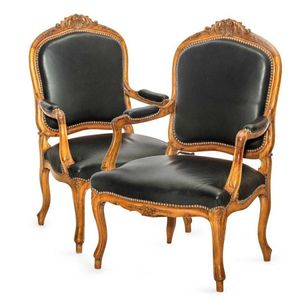French Fauteuils with Salmon Damask Upholstery
A matched pair of French fauteuils with carved cresting, shield shaped backs and seats upholstered in a deep salmon damask, supported on cabriole legs (2) 95 cm high
You must be a subscriber, and be logged in to view price and dealer details.
Subscribe Now to view actual auction price for this item
When you subscribe, you have the option of setting the currency in which to display prices to $Au, $US, $NZ or Stg.
This item has been sold, and the description, image and price are for reference purposes only.
- Cresting - The decorative carving at the top of a piece of furniture, such as a sideboard back, a mirror, or a chair back.
- Damask - Damask is a type of fabric that is characterized by its glossy finish, smooth texture, and intricate designs. The fabric is typically made from a combination of silk and other natural fibers, such as cotton or linen, and is often used to make clothing, upholstery, and other decorative items.
The origins of damask fabric can be traced back to ancient Rome and the Byzantine Empire, where it was used to make clothing and other textiles.
The fabric is made by weaving the fabric in such a way that the design is created by the different reflectivity of the warp and weft threads, rather than by the use of dyed threads. The designs are often floral or geometric patterns and can be very intricate. The effect is a reversible fabric, with a glossy pattern on one side and a matte pattern on the other. - Cabriole Leg - The cabriole leg evolved from an elongated scroll, curving out at the knee which may or may not be carved, and forming a serpentine shape as it descends to the foot.
First introduced into English furniture in the late 17th century, cabriole legs were widely used during the Queen Anne and early Georgian periods, where they frequently terminated in a pad foot or ball and claw foot. The style has had many imitators since then. The cabriole leg was re-introduced in the mid-19th century, and is commonly associated with the balloon-back dining or drawing-room chairs made in walnut, mahogany or, in Australia, cedar. The Victorian cabriole leg, on the whole, was rather more slender than the earlier form, following the French style, which emphasized the delicacy and daintiness of the chairs they were designed to support. Cabriole legs are sometimes found on windsor chairs, especially those made during the 18th century.
This item has been included into following indexes:
-
chairs, singles / pairs / threes, style or period
- fauteuils (arm chairs) 244
- French 966
Visually similar items

A pair of Louis XV style fruitwood fauteuils, with leather covers, French, 19th century
Sold by
in
for
You can display prices in $Au, $US, $NZ or Stg.

Pair of Louis XV style armchairs, white painted frame, with chocolate brown upholstery, on cabriole legs (2), height 92 cm
Sold by
in
for
You can display prices in $Au, $US, $NZ or Stg.

A pair of upholstered Louis XVI style chairs, 20th century
Sold by
in
for
You can display prices in $Au, $US, $NZ or Stg.

A pair of Louis style upholstered armchairs, height 89 cm
Sold by
in
for
You can display prices in $Au, $US, $NZ or Stg.
